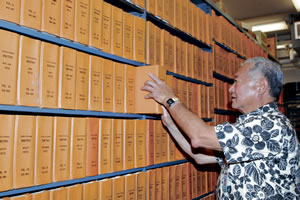Keeping The Records Straight
Interviewed by Rasa Fournier
Wednesday - November 16, 2011
E-mail this story | Print this page | Comments (0) | Archive
 Del.icio.us Share
Del.icio.us Share

Alvin T. Onaka, Ph.D
Registrar at the state Department of Health
How long have you been with the state Department of Health?
I have been the State Registrar since 1989. I have been working for the state government for more than 30 years.
What background led you to become the registrar?
Born and raised in Hawaii, I graduated from Iolani School and received my Ph.D. from the University of Massachusetts at Amherst where I was a population council fellow in demography. I worked for the U.S. Agency for International Development, where I traveled to more than 60 countries to provide technical assistance in health and vital statistics. I did post-doctoral work in epidemiology at the University of Minnesota Medical School, which prepared me for an assignment with the U.S. National Academy of Sciences in Hiroshima, Japan, where I worked for the Department of Epidemiology and Statistics at the Radiation Effects Research Foundation, formerly called the Atomic Bomb Casualty Commission.

|
What does your job currently entail?
I administer the statewide program for birth, death and marriage registration. We measure the vital signs of the population as it relates to births, deaths and marriages. This includes the Hawaii Health Survey, which monitors the health status of all of the people of Hawaii. Our hard-working staff issues approximately 1,000 certified copies of these records every day. There’s a saying in our office: “We serve you at the beginning, in the middle and at the end.”
What’s the annual breakdown in the number of vital events in Hawaii?
We register annually about 10,000 deaths, 18,000 births and as many as 30,000 marriages in Hawaii.

|
How far back do your records go?
We have records that go back to the 1840s. The records are used for many purposes, including proof of age and citizenship, as well as entitlement purposes particularly for persons of Hawaiian ancestry.
Can you talk about the national recognition you received from the Centers for Disease Control and Prevention?
The Vital Statistics Model Law is the oldest model public health law in the U.S. It was developed in 1907 and is revised every 20 years. For the past two years, I chaired the CDC work group that updated the law to reflect changes in medicine, society and information technology, including assisted reproductive technologies, in vitro fertilization, surrogacy, same-sex marriage and civil unions and gender reassignment. These changes affect birth, marriage and death records. After review and approval by the Secretary of Health and Human Services it will become the U.S. Model Law for all the states and U.S. affiliated jurisdictions to adopt.
Our office also recently received a grant from the CDC of approximately $1 million a year for up to five years to develop an electronic vital statistics system that meets national standards and can be shared with the U.S. Affiliated Pacific Islands. My vision is to use the advances in information technology in Hawaii and the Pacific jurisdictions to integrate the vital statistic system for inter-jurisdictional exchange of vital records and for public health surveillance, especially in times of natural and manmade disasters.
E-mail this story | Print this page | Comments (0) | Archive
Most Recent Comment(s):













